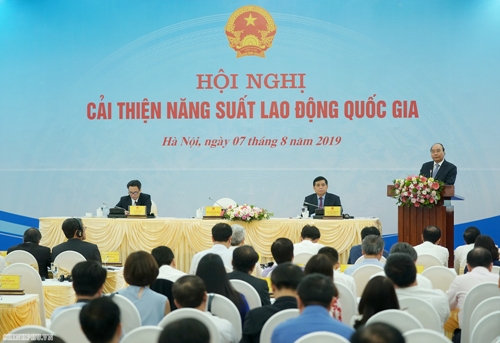PM asks for making breakthroughs in enhancing labor productivity
VGP – PM Nguyen Xuan Phuc expected that the business community, entrepreneurs, investors and people at all levels will join hands to make breakthroughs in improving labor productivity for the fast and sustainable development of the country at the national labor productivity improvement meeting on August 7 in Ha Noi.
 |
|
PM Nguyen Xuan Phuc attends the national labor productivity improvement meeting in Ha Noi, August 7, 2019 - Photo: VGP/Quang Hieu |
Speaking at the event, PM Phuc referred to high growths in Viet Nam’s labor productivity over the recent years, especially in 2018 the labor productivity increasing 6% against the previous year and the average growth of labor productivity in 2016-2018 period reaching 5.8%.
Over the recent five years, the total-factor productivity (TFP) growth exceeded 1.5%, the highest figure since the Asian financial crisis in 1997, according to the analysis of the International Monetary Fund. The TFP growth in the 2018-2023 phase is expected to exceed 1.8%.
The low labor productivity is due to congestions on economic institutions, low professional skills of human resources, lack of high skilled human resources, particularly
He stressed the importance of reforming institution to boost labor productivity, improving the State management capacity, the national competitiveness capacity, upgrading the quality of the business environment, establishing a mechanism to create opportunity for all laborers, thus contributing to the common prosperity of the economy.
Phuc required transforming labor structure from agriculture to industry and services, from simple labor to skilled labor as well as reforming the banking and financial sectors to attract more capital flow into sectors with high labor productivity.
It is necessary to enhance strong and fast reform of the State-owned enterprises to release resources for development, promote and support the private sector and other sectors such as cooperatives to become a crucial force of the economy, especially encouraging the spirit of start-up and innovation, he underlined.
The Government leader asked for continuing attracting Foreign Direct Investment, giving priority to high-quality human resources to coordinate with the domestic economic sector to boost production and productivity of the economy.
The PM asserted the orientation of extensive international economic integration, participating in international commercial and investment flows and global value chains to promote reforms, competitiveness capacity and national productivity.
Six key tasks for improving labor productivity
PM Phuc proposed six key tasks to improve labor productivity in Viet Nam. Firstly, he requested to reform institution for all resources, including human resource that can be mobilized, allocated and used effectively.
He highlighted the importance of upgrading the effectiveness of the labor market in both of supply (laborers) and demand (businesses), ensuring all people and businesses participate in the labor market with the lowest expenditures.
A strong encouragement mechanism is needed to attract talents, professionals and excellent managers to Viet Nam, especially Vietnamese in general and overseas Vietnamese talents in particular, including overseas Vietnamese students, he added.
Phuc suggested establishing an open staff mechanism among State agencies to attract more talents to work for State agencies and create a working environment along with competitive mechanism to select and facilitate talents.
Labor productivity is closely connected with education, capacity and skills of laborers, he said, referring to improving the quality of the education and training system.
Laborers must be equipped with new capital and technology to uphold their capacity, thus investing in science and technology application is a prioritized policy of the Government, he said, adding that training skills for laborers and investment in technology need to be compatible with each other to ensure the best compatibility and efficiency.
By Thuy Dung
